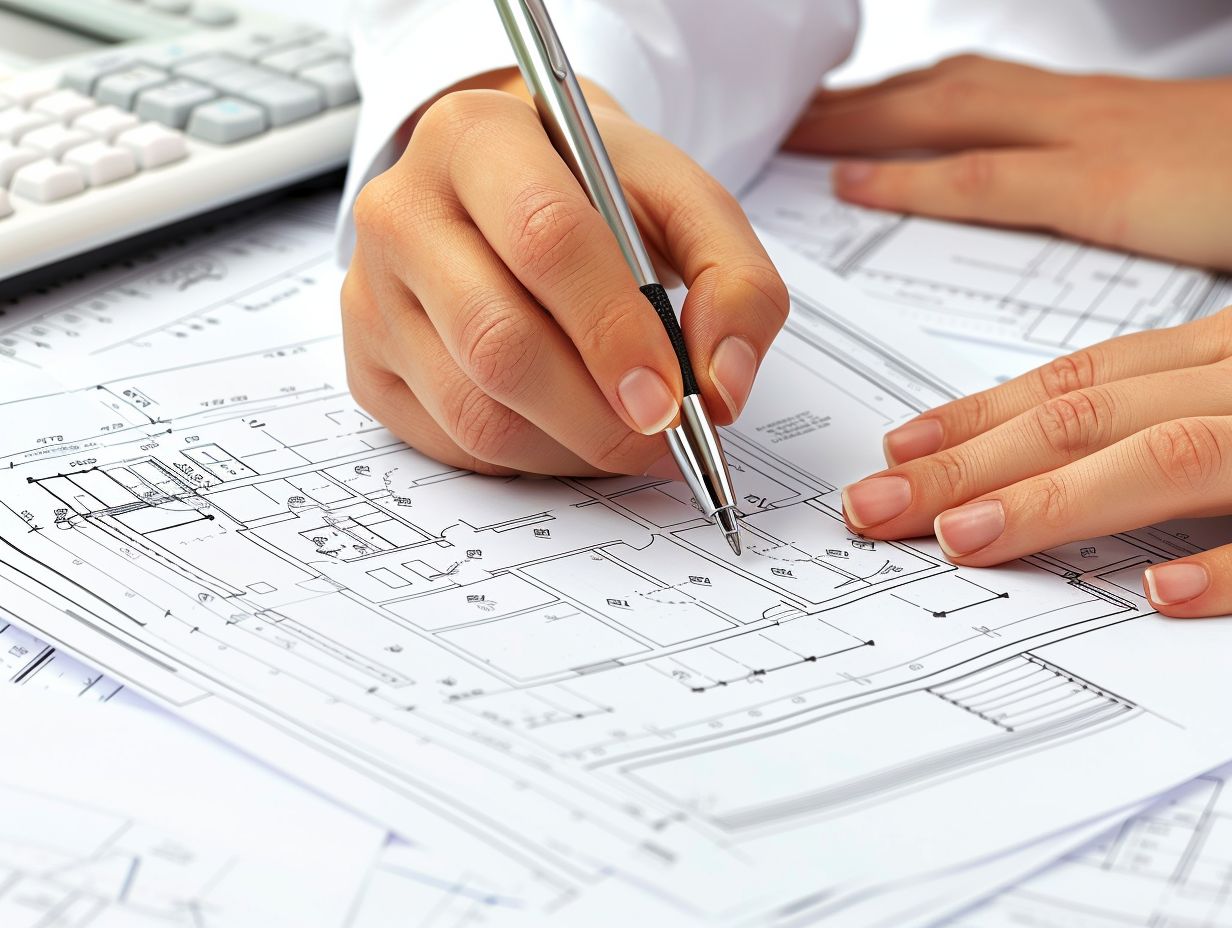
Expert Tips On Choosing Architectural Drawings For Your Home Extension
When considering a home extension project, individuals may find themselves confronted with the daunting task of selecting architectural drawings.
This article aims to simplify the process by providing a comprehensive overview of understanding architectural drawings, outlining the various types available, and presenting key factors to contemplate before finalizing a decision.
Additionally, we delve into the advantages of collaborating with an architect and offer professional guidance on maintaining superior quality and precision throughout the project.
Let us delve into these insights to transform your aspirations for a home extension into a tangible reality.
Understanding Architectural Drawings
A comprehensive understanding of architectural drawings is essential in the construction and renovation processes, as they serve as the visual representation of a design concept prior to its physical realization.
These drawings play a critical role in effectively conveying design concepts from architects to builders, engineers, and clients. For instance, blueprints provide intricate details regarding dimensions, materials, and structural elements of a building. Conversely, floor plans offer a top-down view of the layout, illustrating the arrangement of rooms, doors, and windows.
Through the integration of design elements such as aesthetics, functionality, and sustainability within these drawings, architects ensure that the final structure not only exhibits visual appeal but also complies with safety regulations and maintains structural integrity.
Types of Architectural Drawings
Architectural drawings encompass a variety of types, including construction plans, blueprints, and floor plans, each serving a specific purpose in the design and building process.
Construction plans are detailed drawings that delineate the overall structure of a building, incorporating dimensions, materials, and construction methods. Blueprints offer a visual representation of design specifications, displaying the layout of rooms, walls, windows, and doors. Floor plans provide a top-down view of each level of the building, illustrating the arrangement of spaces and furniture placement.
These drawings play a crucial role in obtaining building permits, ensuring compliance with regulations, and effectively communicating construction details to contractors and stakeholders.
Factors to Consider Before Choosing Drawings
In terms of selecting architectural drawings, it is imperative to take into account several factors such as building permits, local building codes, and zoning laws to ensure the design’s compliance and feasibility. The choice of architectural drawings is also contingent upon the project scope and specific design requirements. Architects must carefully assess the scale and complexity of the project to ascertain the necessary level of detail in the drawings.
Moreover, budgetary considerations play a crucial role in the selection of appropriate drawings, especially considering that more intricate designs may entail higher costs. A comprehensive understanding of the design process is vital as it directly influences the type and quantity of drawings required for each phase of the project. Striking a balance between creative vision and practical considerations is paramount in selecting drawings that align harmoniously with the project objectives.
Budget and Time Constraints
The decision-making process for selecting architectural drawings in a home extension or renovation project is significantly influenced by budget and time constraints, as they directly impact cost estimation and project timelines.
Material selection is a critical factor in cost management and sustainability. Opting for energy-efficient materials may result in long-term savings despite initial higher costs. It is important to find a balance between desired design elements and budgetary constraints.
Applying value engineering techniques can help control expenses while maintaining quality. Project timelines can be streamlined through close collaboration with architects and contractors, establishment of clear milestones, and regular progress reviews. Effective communication among all project stakeholders is essential in managing expectations and ensuring successful project completion within the defined budget and timeframe.
Local Building Regulations
Ahead of selecting architectural drawings for a home extension, it is essential to have a thorough understanding of local building regulations, zoning laws, and building standards. This is crucial for ensuring compliance with legal requirements and preempting potential setbacks during the construction phase. These regulations play a pivotal role in the architectural process, providing guidance to architects and builders on essential steps to acquire necessary permissions for construction.
Conducting a comprehensive site survey is instrumental in evaluating the feasibility of a project based on local zoning restrictions and environmental factors. It is imperative to ensure that architectural plans are aligned with client specifications and adhere to structural standards to facilitate the acquisition of building permits. Additionally, navigating building inspections with precision and promptly addressing any identified issues are integral components of a successful project execution.
Working with an Architect
Engaging with an architect is an essential component of any construction or renovation endeavor, as architects offer a wealth of expertise in architectural design, coordination with structural engineers, and considerations for interior design, all of which contribute to the development of a cohesive and functional environment.
Architects play a pivotal role in translating the requirements of clients into intricate architectural drawings that encapsulate the essence of their vision through innovative solutions. By employing effective project management strategies, architects guarantee the seamless and efficient progression of the construction process, meticulously addressing timelines, budgets, and quality standards. Their collaborative design efforts with clients and fellow professionals yield inventive solutions that not only enhance the aesthetic allure of a space but also optimize its functionality. Furthermore, architects supervise the incorporation of interior design elements, ensuring a harmonious fusion of form and function across the entirety of the project.
Benefits of Hiring an Architect
The engagement of an architect presents a variety of advantages, encompassing professional guidance in architectural design, effective project management, and collaborative design solutions tailored to the client’s requirements and preferences.
Architects bring a wealth of knowledge and experience to the table, particularly in the realm of crafting innovative and functional designs that align with the client’s vision. Their expertise extends to the selection of suitable building materials and construction techniques, thereby ensuring the structural soundness and long-term durability of the project. Architects demonstrate proficiency in project coordination, assuming oversight of all phases of the construction process from inception to finalization, thereby mitigating stress and potential complications for the client. Their adeptness in collaborative problem-solving equips them to efficiently address challenges, resulting in seamless project advancement and the attainment of superior outcomes.
Effective Communication with an Architect
Efficient communication with an architect is paramount for the success of a project, facilitating clear project communication, efficient design collaboration, and well-knowledge-based decision making throughout the design and construction phases.
This collaboration is essential for the seamless coordination of a project, wherein architects and stakeholders collaborate to address challenges and devise innovative solutions. Participation in design workshops enables a thorough exploration of ideas and ensures alignment among all involved parties regarding the project’s vision.
Making timely decisions is pivotal in maintaining project progress and adherence to budgetary constraints. Engaging in value engineering discussions during the design phase aids in optimizing project costs while upholding quality standards, culminating in a successful outcome for all stakeholders involved.
Choosing the Right Drawings for Your Home Extension
The process of selecting appropriate architectural drawings for a home extension requires a thoughtful consideration of various factors, including design preferences, space utilization, and building aesthetics. This deliberation aims to ensure a seamless integration of the new structure with the existing space.
Key elements such as building scale hold significant importance in shaping the overall appearance and ambiance of the extension, thereby ensuring harmonious alignment with the existing structure. Moreover, the incorporation of sustainability practices within the design can greatly enhance energy efficiency and minimize environmental impact.
A meticulous assessment of the room layout is imperative to optimize functionality and maintain a smooth flow within the extended space. By carefully balancing these components in a cohesive manner, one can achieve a successful home extension that not only fulfills practical requirements but also enhances the aesthetic allure of the living environment.
Assessing Your Needs and Wants
Ahead of finalizing architectural drawings for a home extension, it is imperative to conduct a thorough assessment of the client’s needs and preferences. This includes aligning client requirements with the design process and comprehensively understanding the integration of new building components into the existing structure.
The exploration of design innovation is a vital component in the development of concepts. Creative solutions are meticulously crafted to enhance space functionalities while maintaining alignment with the desired aesthetic. The iterative nature of this process involves continuous refinement based on client feedback to ensure that the final design aligns with their expectations.
Once the design concept has been solidified, detailed construction documentation is meticulously prepared. This documentation outlines every aspect of the project, facilitating a seamless execution of the construction process. This meticulous approach guarantees that the envisioned home extension not only meets but exceeds the client’s expectations.
Considering the Existing Structure
When selecting architectural drawings for a home extension, it is essential to carefully consider the existing structure. This involves integrating space planning, design elements, and building components to facilitate a seamless integration of the new and old spaces.
Through a comprehensive project evaluation, homeowners can evaluate the practicality of the proposed extension within the current layout. Design reviews serve a critical function in ensuring that the new space aligns with the aesthetic and functional objectives of the renovation. It is imperative to assess the structural soundness of the building to provide adequate support for the additional space.
Furthermore, it is important to incorporate regular building maintenance considerations during the planning phase. This will help ensure the longevity and operational efficiency of the extended home.
Tips for Ensuring Quality and Accuracy
Ensuring quality and accuracy in architectural drawings necessitates a meticulous review and revision process, alongside efficient collaboration with contractors and builders to rectify any discrepancies and uphold design integrity.
A fundamental advice for upholding quality in architectural drawings is to deliberate on the building systems within the design. An understanding of how various systems interplay and influence one another can mitigate errors during the construction phase. Remaining abreast of the latest design challenges and industry innovations can enhance the precision of architectural drawings.
Close collaboration with construction professionals throughout the project implementation guarantees that any alterations or adaptations are communicated effectively, resulting in a successful and well-executed architectural design.
Reviewing and Revising Drawings
The review and revision of architectural drawings are integral components of the design process, serving to obtain design approval, effectively communicate design intent, and align with client expectations prior to advancing to the construction phase. This critical stage is where design theory is translated into practical application, and design specifications are meticulously scrutinized to align with project objectives.
The utilization of design presentation techniques holds significant importance in presenting the design vision to clients and stakeholders, thereby enhancing comprehension of the proposed architectural solution.
Incorporating client feedback into the revision process ensures that the final design not only fulfills aesthetic requirements but also addresses functional and practical considerations. This integration results in a successful and well-executed architectural project that meets the needs and expectations of all involved parties.
Collaborating with Contractors and Builders
Engaging with contractors and builders during the architectural design phase is crucial for ensuring seamless project coordination, effective construction management, and adherence to building inspection standards, thereby facilitating the successful completion of the project.
Involving contractors and builders early on allows for the timely identification and resolution of potential issues, thereby streamlining the construction process. Close collaboration enables accurate translation of design portfolios into construction documentation, ensuring that the building layout is constructed according to the intended vision. Furthermore, conducting building inspections in collaboration with contractors helps to uphold quality standards and regulatory compliance, resulting in a final product that meets all necessary requirements. This integrated approach promotes teamwork and communication, ultimately improving overall project efficiency and effectiveness.




No Comments